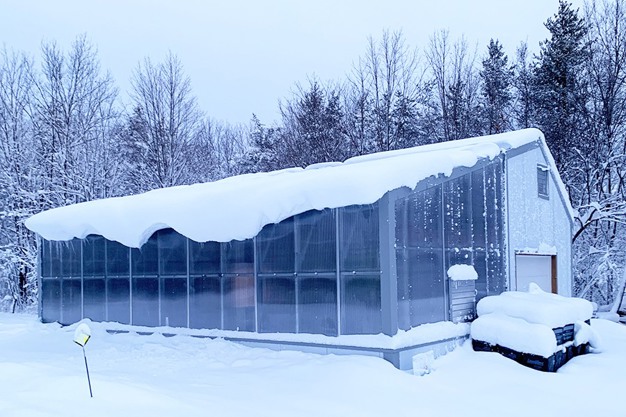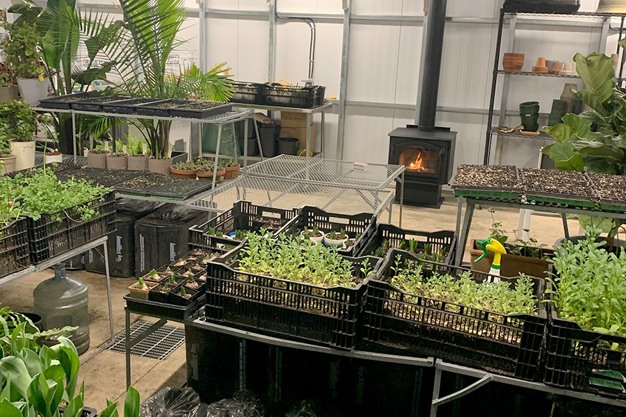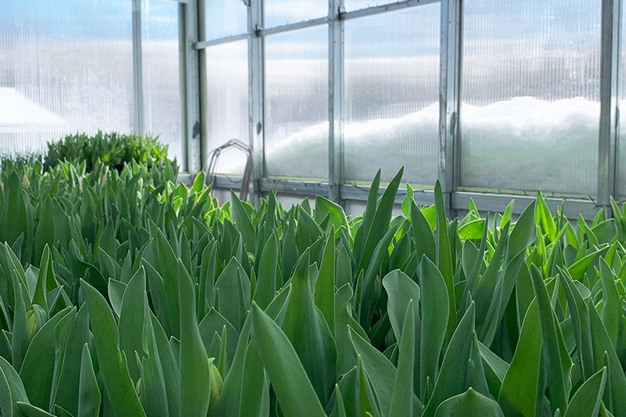Brenda Visser’s green thumb runs in her bloodline, with a great-great-grandfather who owned a greenhouse in the Netherlands. It’s no surprise then that she left her administrative job when she felt a calling to pursue her passion for gardening. When Brenda enrolled in a master gardening course, it set her on a path that eventually led to owning a local cut flower farm at her home in Prescott, Ontario. After successfully running a flower stand during the pandemic, Brenda decided to take her venture to the next level. Today, her farm, Flowers of the Field, is thriving, thanks in large part to a Ceres greenhouse that allows her to grow year-round.
Situated in southern Ontario, just an hour south of Ottawa, Brenda faces the challenges of Canadian climate zone 4. With a short growing season and winter temperatures plunging to -20℃ (-4°F), most of the region’s cut flowers are imported and often treated with chemicals for preservation. Due to the intense winters, local flower greenhouses are mostly seasonal, leaving a gap that Brenda aimed to fill.

To tackle this, Brenda needed an insulated greenhouse that wouldn’t break the bank to heat during the harsh winters. She opted for a Ceres greenhouse, engineered to suit her local climate. Ceres designed a HighYield™ Kit with a 3 ft truss spacing (instead of 4 ft) to withstand snow loads and meet her township’s wind load requirements. Below the concrete floor of the greenhouse, the foundation is insulated, which helps minimize the need for additional heating. Due to the insulative properties of her structure, Brenda kept the greenhouse above freezing last winter by installing a wood stove and using one or two space heaters from her house.

Another advantage of her Ceres greenhouse is not having to shovel snow off the roof during or after a storm. Last winter, there were times when the roof was covered under almost 2’ of snow, and Brenda slept peacefully, knowing the structure was strong and would not collapse under the weight.
Inside her greenhouse, Brenda conducts flower experiments and forces tulips to bloom out of season. She achieves this by planting bulbs in crates in late summer or early fall and then tricks the bulbs into thinking it’s winter by placing them in a cooler, slightly above freezing, for 13-17 weeks. The crates are then transferred to the greenhouse in staggered intervals, and the tulips emerge around three weeks later. Her fresh, local tulips are a hit at the Ottawa Farmers Market during the winter months, offering a burst of color against the snowy backdrop.
In addition to tulips, Brenda cultivates anemones, ranunculus, dahlias, and perennial seed trays. She also uses the greenhouse in the spring to start all the annual flowers for field growing. Looking forward, she plans to host events like wreath-making workshops in the greenhouse during the fall and winter seasons.
While the greenhouse is a new addition to her farm, it complements the original outdoor growing beds that define Brenda’s business. Her house and greenhouse sit on nine acres of woodland property, with approximately 1.5 acres under cultivation. Rather than disturb the trees, Brenda and her husband planned her outdoor flower beds between them, giving the farm a wild, natural aesthetic. However, this setup lacks an easy irrigation method, requiring Brenda to manually water her beds. To thrive outdoors, her flowers must be hardy and drought-resistant, with sunflowers and lisianthus being prime examples. The greenhouse helps to produce healthy flower starts that will be strong enough to be transplanted outdoors, ensuring a healthier and more successful garden.

As Brenda enters her second winter with the greenhouse, she plans to make adjustments based on her experience from last year. She’s investing in a larger space heater, and more grow lights to double her tulip production during the winter. Overall, Brenda is delighted with her greenhouse, particularly the system automation managed by her SunSense™ controller. With fewer concerns about tasks like turning fans on and off, she can dedicate more time and attention to her beloved flowers. A solar analysis done by her engineer, which identified the optimal location and angle for the greenhouse to maximize sun exposure, has also proven invaluable, especially during the winter months.
She mentioned that, during the summer months, her Ceres greenhouse has also proved its worth by providing a stable growing environment that did not overheat, particularly for her dahlia’s.
Brenda’s future looks bright as her flower farm continues to flourish. She supports the local flower movement by offering farm tours in the summer to fellow growers. If you’re in Ontario, particularly in the Ottawa area, be sure to explore flowersofthefield.ca for all your customized floral needs.
For more information: Ceres Greenhouse Solutions
Ceres Greenhouse Solutions
1898 S. Flatiron Ct, Ste 125 Boulder
CO 80301, USA
Tel.: 303-495-5006
info@ceresgs.com
www.ceresgs.com
